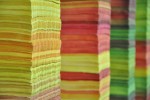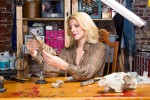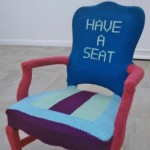If hatred and fear of colors other than black and white exist in the art world, as David Batchelor persuasively argues in his book, Chromophobia, the opposite of color-hate, chromophilia, fuels Katie Murken‘s new installation opening this Friday in her DIY pop-up gallery at 319 N. 11th St. (the Vox building).
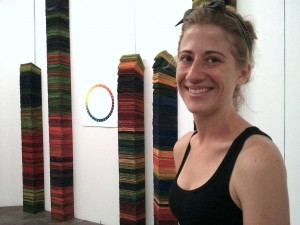
We met the artist recently while she and her team were installing the piece at 319 N. 11th, Studio 2J (second floor). Murken, who is a book artist and teaches color theory at Tyler, has been planning and toiling on the massive installation for 2 years, and probably incubating it in her mind for even longer. Continua is a hue-licious homage to her beloved colors.
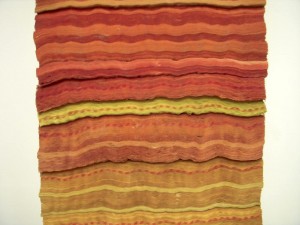
Murken’s piece involves 24 tall columns of color, each made of 24 colors, that line up against an octagonal-walled space she created within the studio. The columns — stacks of hand-dyed paper — are tall bars of saturated color that seem transported from a cyber bar chart into the real world. Unlike the bars in a bar chart, though, they don’t measure population growth or number of blueberry boxes sold in New Jersey this season. Instead, they reflect the results of a game Murken plays with her color wheel and a pair of dice. In other words, the color placement is part chance and part probability, with a mathematical underpinning that John Cage would love.
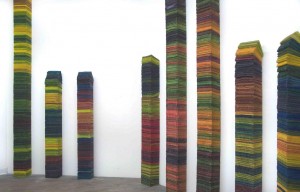
We loved the texture and feel of the columns, and, of course, the saturated colors, which somehow triggered thoughts of the color festival, Holi, in India that involves people flinging powdered pigment and colored water on each other–people in euphoria head over heels in love with color. The big bars also brought up thoughts of geology — those sedimentary layers built up within the earth. And of course, time. For the build up of color in these minimalist columns must have taken months and months of toil and represent hours of work by many people.
This is Murken’s first solo exhibition.
Here’s our q&a with the artist, conducted Aug. 19, 2011.
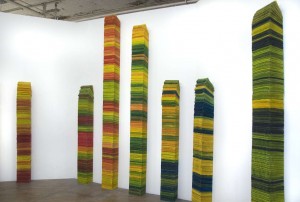
How big are the columns and what are they made of? Their texture is nice–almost like felt, or maybe tissue paper.
They are phone books (yellow books) stripped of their covers, stripped of their identities. There are 60,400 pages per column. All the books are broken in half. I play with 95-page increments.
Tell more about the phone books. That’s a lot of phone books — what’s your source?
At first I scavenged them from my South Philly neighborhood. [People leave them out in front of their houses and don’t want them so they’re free resources. She likes that they are part of a passe technology.] Then I needed more. I found the warehouse for yellow book and used all the Philadelphia yellow books until they ran out. Then I want on to the Louisville phone books.
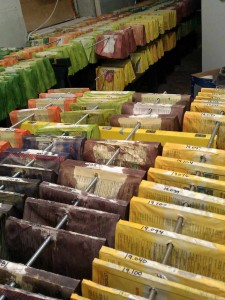
How do the Philly and Louisville books differ?
I found out there are three different types of paper in one of the Philly books. And the restaurant pages are [printed] checkered on the edge. The Louisville book doesn’t use three different papers.
How did you find the warehouse?
I just called up the yellow book people and they were helpful. They told me about the warehouse. It’s in Hazleton, PA.
Did they charge you for the books?
No, they were free.
So where did the idea come from?
I teach color theory. David Batchelor is an influence. Teaching color theory is about how colors interact and the effects they have on each other. It’s not about how to produce nice effects per se.
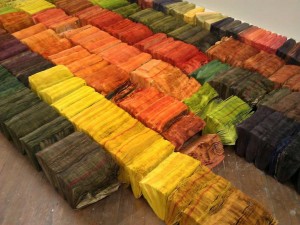
Where do you get your dyes? And are they powders you have to mix?
Dharma Trading Company in California. They’re non-toxic. The dyes are so expensive it’s ridiculous, but I’m getting very true colors. The company can’t keep up with my need. The dyes are liquid. I dilute the dyes 10x for my use.
Where do you do the dying? In a utility tub?
I dye them in disposable aluminum roasting pans. [She shows us how she dyes them–dipping the three outer edges of the book, one edge at a time, in the dye, which gets absorbed up the paper but not all the way to the middle of the book.]
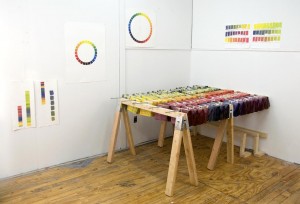
Tell us about your system of choosing colors?
[She points to a hand-made color wheel on the wall with some lines drawn between opposites.] There are two complementary colors per column and I add a third color. Then I roll the dice [to find the rest of the 24 colors per column]. Each time I move, I select a color.
Did you ever consider choosing the colors intuitively…without a system?
I don’t want to choose the colors myself, but let the colors speak independently.
Are you a math geek?
I didn’t think so, but there’s something in there…
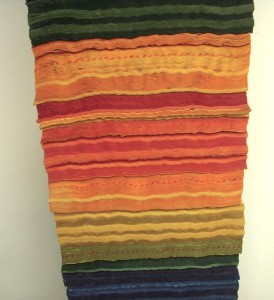
Will this project change how you teach color theory?
Yes — I’ll teach this project.
What’s a typical day on the project?
I mix dyes; I roll dice; I make calculations [on what colors go where in the installation], using an Excel spreadsheet.
Are you installing by yourself?
I wanted to but no. My husband, Paul White, is installing. I had to let that go….I always fear the installation because you never know what you’re going to get. It’s the phase where all the unexpected things happen.
How much is the rent on this space?
$1600 for two months. The landlord asked $1900…
Continua – Installation by Katie Murken
319 N. 11th St., Studio 2J (second floor)
Sept 2-Oct. 7, 2011
opening reception Friday, Sept. 2, 4-9pm
closing reception Friday, Oct. 7, 4-9pm


